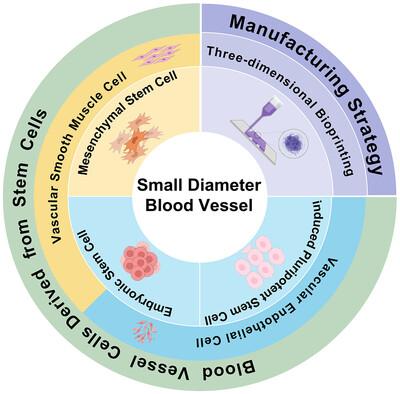Stem-Cell-Based Small-Diameter Blood Vessels with 3D Printing
IF 11.1
Q1 MATERIALS SCIENCE, MULTIDISCIPLINARY
引用次数: 0
Abstract
Cardiovascular disease has emerged as the leading cause of death worldwide. Since coronary arteries, carotid arteries, and other blood vessels are prone to narrowing, small-diameter artificial blood channels offer a crucial solution for restoring blood flow. Ideal grafts must emulate the structure of natural blood vessels, possess adequate mechanical strength, ensure long-term patency, and incorporate functional cells with minimal immunogenicity. Enhanced cell sources and engineering methods are vital for the creation of functional small-diameter blood vessels (SDBVs). Among potential cell sources, stem cells stand out due to their ability to differentiate into multiple cell types, self-renew, and exhibit low immunogenicity. Additionally, three-dimensionally (3D) printed vascular stents have attracted widespread attention for their precision and controllable bioink application. The need for tissue-engineered blood vessels is currently rising, and innovative design concepts integrating stem cells and 3D printing present promising solutions. Herein, the construction requirements of vascular grafts are reviewed, current status of using stem cells as a cell source and 3D printing as an engineering strategy is described, and prospects and challenges for the development of SDBVs in the medical field are discussed.

基于干细胞的三维打印小直径血管
心血管疾病已成为全球死亡的主要原因。由于冠状动脉、颈动脉和其他血管容易狭窄,小直径人工血液通道为恢复血流提供了重要的解决方案。理想的移植物必须仿效天然血管的结构,具有足够的机械强度,确保长期通畅,并结合免疫原性最小的功能细胞。增强细胞来源和工程方法对创建功能性小直径血管(SDBV)至关重要。在潜在的细胞来源中,干细胞因其能够分化成多种细胞类型、自我更新和免疫原性低而脱颖而出。此外,三维(3D)打印血管支架因其精确和可控的生物墨水应用而受到广泛关注。目前,人们对组织工程血管的需求日益增长,而将干细胞和三维打印技术相结合的创新设计理念则为人们提供了前景广阔的解决方案。本文回顾了血管移植物的构造要求,阐述了使用干细胞作为细胞源和三维打印作为工程策略的现状,并讨论了SDBV在医疗领域的发展前景和挑战。
本文章由计算机程序翻译,如有差异,请以英文原文为准。
求助全文
约1分钟内获得全文
求助全文
来源期刊
CiteScore
14.00
自引率
2.40%
发文量
0
期刊介绍:
Small Science is a premium multidisciplinary open access journal dedicated to publishing impactful research from all areas of nanoscience and nanotechnology. It features interdisciplinary original research and focused review articles on relevant topics. The journal covers design, characterization, mechanism, technology, and application of micro-/nanoscale structures and systems in various fields including physics, chemistry, materials science, engineering, environmental science, life science, biology, and medicine. It welcomes innovative interdisciplinary research and its readership includes professionals from academia and industry in fields such as chemistry, physics, materials science, biology, engineering, and environmental and analytical science. Small Science is indexed and abstracted in CAS, DOAJ, Clarivate Analytics, ProQuest Central, Publicly Available Content Database, Science Database, SCOPUS, and Web of Science.

 求助内容:
求助内容: 应助结果提醒方式:
应助结果提醒方式:


